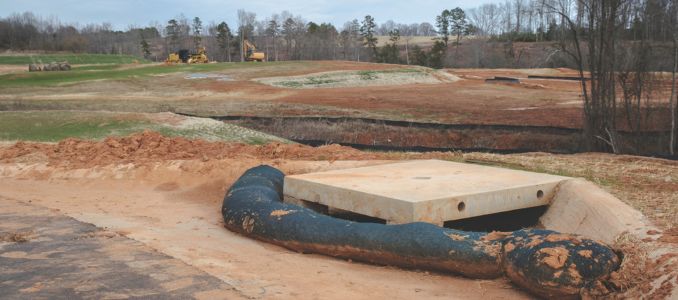
Stormwater and Facility Safety: How to Filter Out Pollution Before It Spreads
Runoff from industrial sites and facilities can carry contaminants that threaten both the environment and workplace safety. Here’s how smart filtration strategies help control pollution and protect your people
- By Dan Ankney
- May 01, 2025
It might seem like marinas, construction sites, scrapyards, gas stations, and public parks have very little in common, but they share one important environmental problem—stormwater pollution. There are many federal, state, and local regulations that require individuals to protect stormwater from pollution. The EPA defines stormwater as stormwater runoff, snow melt runoff, and surface runoff and drainage. The type of pollution exposed to stormwater and the measures put in place to protect against pollution will look different for everyone.
You may be asking yourself what stormwater pollutants are and how you can keep them from entering stormwater. The following should provide a good understanding of some common pollutants and filter options.
Types of Pollution
The EPA’s National Pollutant Discharge Elimination System (NPDES) defines a pollutant as:
“Pollutant means dredged soil, solid waste, incinerator residue, filter backwash, sewage, garbage, sewage sludge, munitions, chemical wastes, biological materials, radioactive materials (except those regulated under the Atomic Energy Act of 1954, as amended—42 U.S.C. 20111 et seq.), heat, wrecked or discarded equipment, rock, sand, cellar dirt and industrial, municipal, and agricultural waste discharged into water.”
The three most common and easily filtered pollutants are explained below.
- Sediment, debris, and floatables: This is the broadest scope of pollutants and can include things like leaves, cigarette butts, sand, dirt, and microplastics. They have the largest potential to enter every drain, retention pond, or swale.
- Oil and fuel: Oil and fuel pollution can occur from many sources like a leaking engine, blown hydraulic line on a piece of heavy equipment, or a rust preventative coating on metal parts. Since hydrocarbons aren’t miscible with water, they spread easily but are readily captured by stormwater filters.
- Heavy metals: Dissolved heavy metals can be a more difficult pollutant to capture, but there are solutions. Common metals that can be found in stormwater include zinc, cadmium, chromium, lead, and copper. Sources for dissolved heavy metal pollution include scrap metal, byproducts created from metal fabrication, and runoff from metal roofs.
Types of Filtration Products
There is a broad range of stormwater filtration products on the market; each option is designed to capture pollutants at a different point in a stormwater discharge flow, and each will remove specific pollutants.
Some of the most common types of filtering products include:
- Filtering socks: If the source of the pollution is known, the filter sock can be placed at or around the point source. If the point source is unknown, it can be used as a perimeter control to cover a large area.
- Drain inserts: If the point source is unknown, one of the best locations to filter stormwater is at the drain since that’s the point where stormwater is diverted.
- Dewatering bags and pipe socks: Horizontal discharge pipes or pumping applications can pose a challenge when removing pollutants. Dewatering bags or pipe socks can be used to remove pollutants from these areas.
When stormwater filtration products are installed, it’s important to routinely sample the discharge. This will determine if your filtration products are still effectively removing pollutants. Collected sediment, debris, and floatables should also be removed from the filters.
Treatment Trains
In some cases, a single layer of filtration doesn’t get the job done. This is when a treatment train comes into play. A treatment train is the process of using layers of filtration products at various stages of stormwater drainage. With more filtration at various stages, you can increase the removal percentage of pollutants in your stormwater. This is extremely effective when you know the point source of a stormwater pollutant.
A construction site is a great example of a location where a stormwater treatment train can be beneficial. When vegetation and soil are moved on a construction site, it increases the ability for sediment and debris, along with many other pollutants, to travel through stormwater.
To start a treatment train, filtration socks are a great first line of defense. They can be used around stockpiles of raw material, as a perimeter control around the construction site, and around heavy equipment.
The second level of a treatment train would be drain filters. They would be placed over or under the storm drain grate to filter pollutants directed to these areas. Filters will help collect the sediment and debris that flows toward drains.
The final location to capture stormwater pollutants before they’re discharged is outflow ports. Dewatering bags and pipe socks can be used as the last line of defense in your treatment train. Typically, you’ll want to have the majority of sediment and debris removed before this point.
Conclusion
Now that you know what an effective treatment train looks like, you can add these methods to your portfolio of ways to meet environmental responsibilities. Explore your options to find the best stormwater products to help you comply with EPA regulations and protect our waterways.
This article originally appeared in the April/May 2025 issue of Occupational Health & Safety.